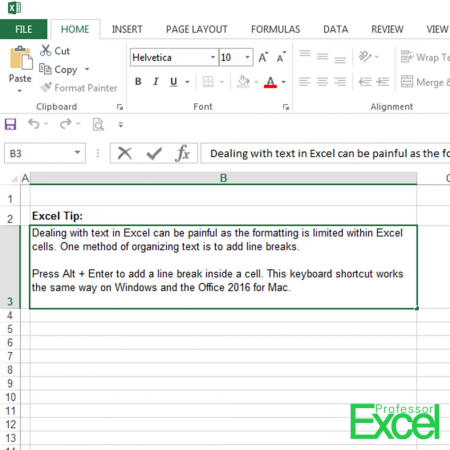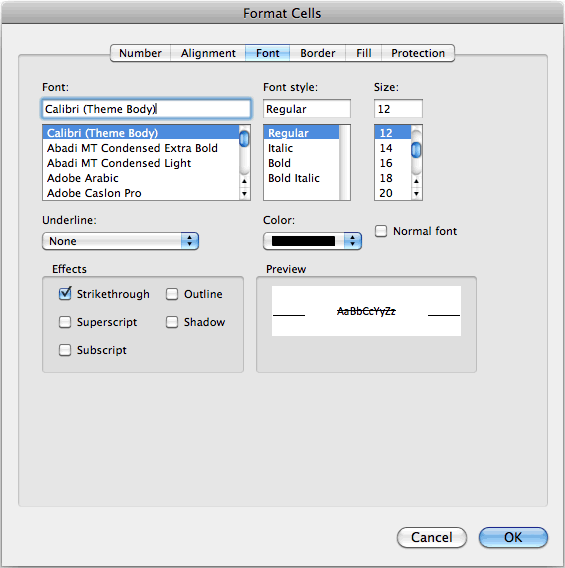
- #Excel 2011 for mac add line retuen in a cell how to
- #Excel 2011 for mac add line retuen in a cell install
- #Excel 2011 for mac add line retuen in a cell driver
- #Excel 2011 for mac add line retuen in a cell windows 7
It was for the then current version of the product – Excel 2007. Quite some time ago, summer 2008, I wrote a post about how you could embed an image in a cell comment. You should take note that Microsoft’s future direction adopts Oracle ODBC, like the approach they’ve chosen with MySQL’s ODBC driver. Once you’ve downloaded it, you can return to this post where you set up an Excel query against a remote Oracle database.
#Excel 2011 for mac add line retuen in a cell driver
This driver contains the necessary OLE DB and ODBC drivers, as you can see in this screen shot. It’s in the driver sections, as shown in the screen capture below:
#Excel 2011 for mac add line retuen in a cell install
The person who posed the question doesn’t have Oracle installed locally and can’t install it.įor those who don’t have an Oracle instance running locally, you can download the Oracle Data Access Components for Windows from the Oracle web site.
#Excel 2011 for mac add line retuen in a cell windows 7
It appears I assumed too, like everyone would know that it’s on Windows 7 when Oracle 11g (or another Oracle database) is installed locally. Posting this screen shot may not have helped either. I’d referred them to this post on adding MySQL’s ODBC driver to Windows 7 but that didn’t help enough.

Somebody was trying to query Oracle via Microsoft Excel 2007, and didn’t have an Oracle ODBC Data Source that enable them to choose Oracle. It would be more appropriate to, from my perspective, use a FOR range loop, like this: I only chose a DO UNTIL loop because that was in the comment. 'Return a 1 when the value is found and zero when it isn't. ' Assign a 0 (zero) as a false return flag value. ' Fail safe exit when no matching value is found. ' Loop until found, but exit when not found.ĭo Until lookupRange.Cells(lookupIndex, 1).Value = lookupWord Loop 'Return a 1 when the value is found and zero when it isn't.įunction Finding(lookupWord As String, lookupRange As Range, lookupColumn As Integer) As Integer If lookupIndex = (lookupMax + 1) Then ' Assign a 0 (zero) as a false return flag value.Įxit Do End If ' Increment counting index value. ' Print diagnostic value to determine what's evaluated. Do Until lookupRange.Cells(lookupIndex, 1).Value = lookupWord ' Loop until found, but exit when not found. ' Print starting and ending index values. Dim lookupIndex As Integer Dim lookupMax As Integer Dim returnValue As Integer ' Assign values to variables. While DAX is powerful, it doesn’t replace the speed and query optimized behaviors of effective Oracle or MySQL queries.įunction Finding(lookupWord As String, lookupRange As Range, lookupColumn As Integer) As Integer ' Define variables.


Remember the more refined the data model you start with the easier it is to structure analytical tools to leverage the data model. You should always pre-select data before applying analytics in Excel. Just one caveat if you’re using an Oracle or MySQL database, use the prepackaged analytic functions before you download the data set. However, if you’re like most folks, you want a book to get you up-to-speed quickly, and that’s what this book will do for you. DAX works with tables but if you don’t use tables, I guess you can skip DAX because you must have infinite time to produce marginal analytical outcomes (tongue in cheek humor).
#Excel 2011 for mac add line retuen in a cell how to
I’d like to recommend Microsoft Excel 2013 Building Data Models with PowerPivot to those who haven’t learned how to use DAX in Excel 2010, 2011, or 2013. DAX is truly a powerful extension to the analytical and modeling approaches in Microsoft Excel. Clearly, the Data Analysis eXpression (DAX) Language introduced in Excel 2010 went unnoticed by many, which was sad.

I’ve worked with every release of Microsoft Excel, and I know it takes effort to keep up to date with certain releases.


 0 kommentar(er)
0 kommentar(er)
